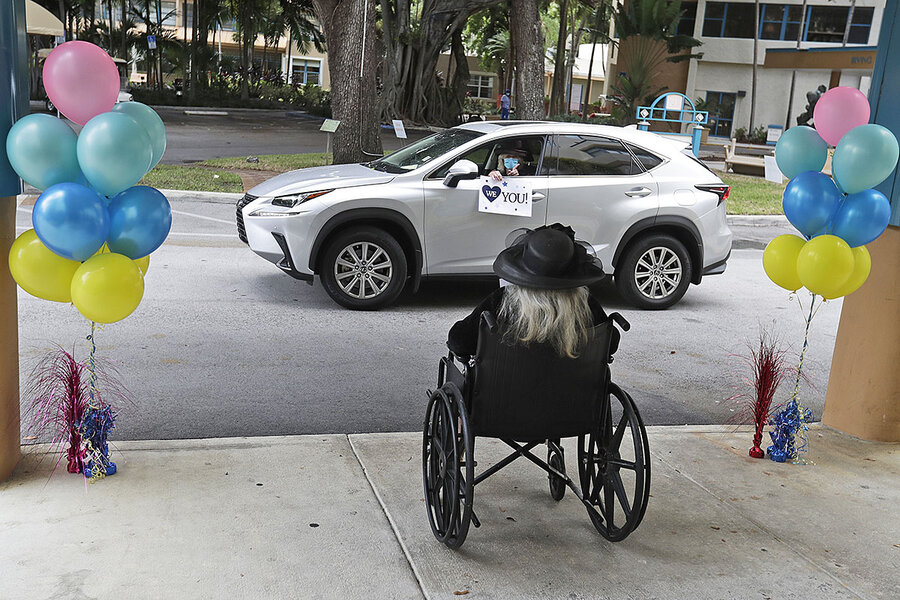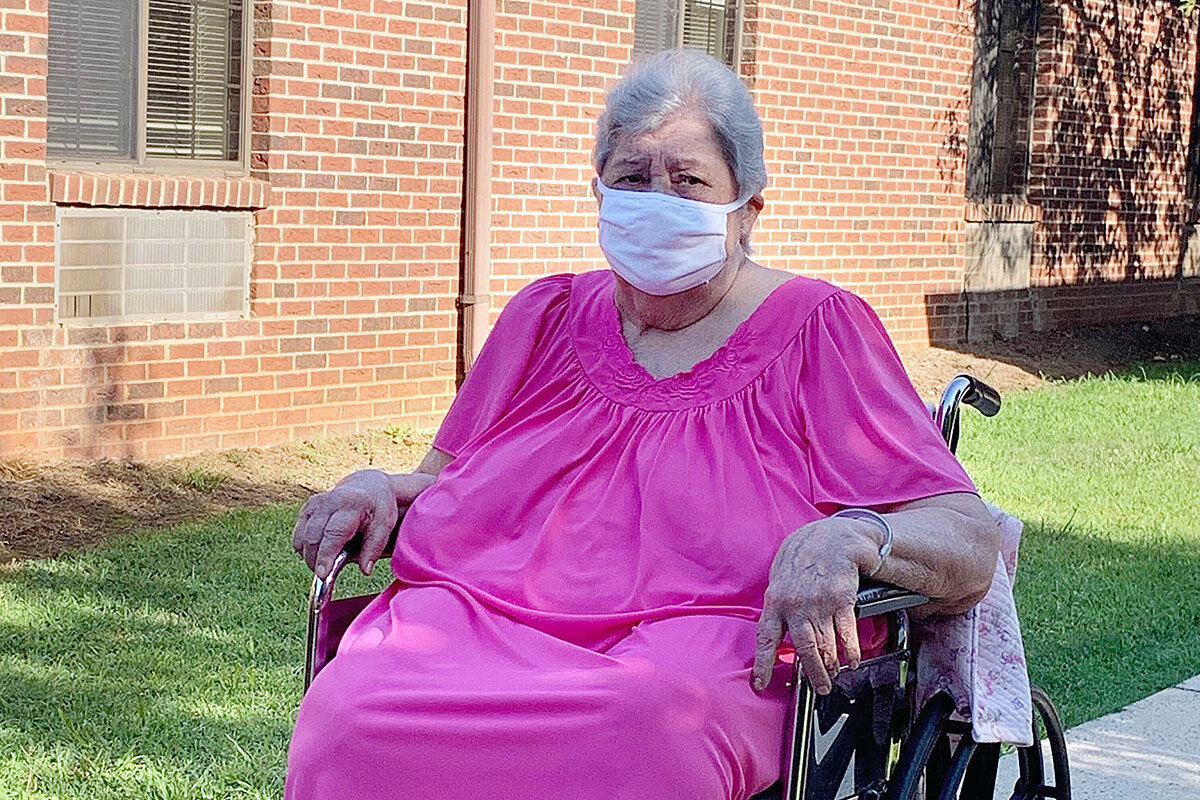What nursing homes need: Lockdown safety – and room for hugs
Loading...
| New York
Nursing home facilities face high-stakes decisions about how to reopen safely after nearly half a year in lockdowns designed to protect older adults who are considered most vulnerable to COVID-19.
Social isolation, say some experts on aging, is a second affliction in the pandemic that has killed an estimated 75,000 long-term care residents and staff nationwide. The lack of physical contact with loved ones for such an extended period can cause depression, anxiety, and overall health decline.
Why We Wrote This
Nursing homes face a tough moral decision: Protect patients from the virus with strict lockdowns or carefully ease the isolation that deprives them of the vital – healing – connections of visits from family and friends.
“There are many instances where we’ve seen that our patients are not declining because of COVID, but they’re declining because of lack of interaction with family members,” says Grace Jenq, associate clinical professor of geriatric and palliative care medicine at the University of Michigan in Ann Arbor.
Uneven state and federal regulations make for a confusing map of how to safely ease restrictions, but it’s certain that most reunions of nursing home patients and their families will come for the foreseeable future at a wrenching 6-foot distance.
Desperate for reconnection, relatives of the more than 1 million nursing home residents have scrambled for creative workarounds – from strained video calls to bucket truck-assisted window visits.
The basic question in considering reopening, says one nursing home CEO: “Is it safe?”
When Mildred Brown arrived for physical therapy at a North Carolina nursing home in February, the octogenarian who had been living independently until then could pace about 150 feet with her walker without sitting down. Now, six months after she and thousands of other nursing home residents nationwide were placed in lockdowns designed to protect them from COVID-19, Mildred appears depressed and can barely get out of bed, says her daughter Laura Brown.
“Her spirits were great in February. Since the isolation and lockdown, she’s just deteriorated,” says Laura, who echoes a growing sentiment among experts on aging that some long-term care residents experience health decline not because of COVID-19, but lack of human contact.
Since a family visit on Mother’s Day – allowed because it appeared for over a week that Mildred was so ill she might die – she has gone four months without a loved one’s embrace.
Why We Wrote This
Nursing homes face a tough moral decision: Protect patients from the virus with strict lockdowns or carefully ease the isolation that deprives them of the vital – healing – connections of visits from family and friends.
When Laura eagerly arrived for a half-hour visit in the facility’s courtyard July 30, her mother wept. But Mildred’s wheelchair was parked a few feet beyond her daughter’s reach. As the women strained to hear each other behind their masks, their natural urge to touch was crushed by staff warnings that future visits would be barred if they did.
“It was torture,” says Laura. “They watched us just like we were in jail.”
Mildred cried even harder when the visit ended.
Nursing homes closed their doors to most visitors in March in an attempt to shield vulnerable residents from the virus, which has killed more than 75,000 residents and staff in long-term care this year, according to early-September Kaiser Family Foundation data. But cautionary confinement has meant a second affliction for residents, and not just for those who missed final goodbyes.
“There are many instances where we’ve seen that our patients are not declining because of COVID, but they’re declining because of lack of interaction with family members,” says Grace Jenq, associate clinical professor of geriatric and palliative care medicine at the University of Michigan in Ann Arbor.
Some experts on aging say isolation can lead to depression, anxiety, and overall health decline.
Desperate for connection, relatives of the country’s more than 1 million nursing home residents have scrambled for creative workarounds – from strained video calls to bucket truck-assisted window visits.
And now, care facilities face high-stakes decisions about how to reopen safely. That means most reunions will come for the foreseeable future at a wrenching 6-foot distance.
In Colorado, for example, where until Sept. 3 only outdoor visits had been permitted, many locals have complained that reopening residential care facilities has been too slow, says Randy Kuykendall, director of the health facilities and emergency medical services division for the state Department of Public Health and Environment.
“My heart breaks for them, because I understand,” says Mr. Kuykendall. “But again: Lives are on the line here.”
Similarly safety-conscious, Evan Lubline, CEO of Hooverwood Living in Indianapolis, which only offers outdoor visits, says: “The inside visits are something we’re definitely wanting to explore. But the question goes back to: Is it safe? ... I feel really bad for those families. This isn’t fair to them.”
Uneven regulation
Since early June more than half of states have allowed long-term care facilities to reopen gradually to visitors, though it’s unclear how many families have been able to visit.
Federal guidance leaves wide room for interpretation, making for a piecemeal rollout. Several states have permitted only outdoor visitation because the risk of the virus’s transmission is considered lower outside. Facilities have found creative ways to support these connections, including one Virginia nursing home whose glass barrier set up outside allowed for handholding through plastic gloves. Underscoring the uneven process, the Monitor encountered four cases of long-term care facilities that offered outdoor visits before their states issued guidelines on resuming visitation.
While the pandemic continues to course through much of the country, some industry watchers say there are risks in reopening too soon, especially with ongoing shortages of staff and personal protective equipment.
“I’m deeply concerned with the lack of transparency, the lack of consistency, the lack of commitment by nursing homes and assisted living facilities in ensuring that basic health and safety standards are being met to allow for safe visitation,” says Elaine Ryan, vice president for state advocacy and strategy at AARP. “Death counts cannot be our measure of how well we’re doing.”
Only seven states had required ongoing testing of residents, staff, or both in long-term care as of mid-July, Stateline reported. And the federal government began requiring regular COVID-19 testing for nursing home staff on Aug. 25, six months after the pandemic’s first nursing home deaths in Washington state.
Supporters of controlled visitation argue that infection risks should be weighed against the physical and emotional well-being of residents. Dr. Jenq says lack of social interaction has even caused some nursing home residents to lose their abilities to perform simple activities of daily living, like walking or eating.
“The benefits [of visits] are really enormous,” says Peter Lichtenberg, director of Wayne State University’s Institute of Gerontology in Detroit, who also speaks from personal experience. After weeks of isolation, he visited his own father for an end-of-life exception visit at a Pennsylvania facility this spring.
“My dad died without anxiety,” says Dr. Lichtenberg. “I thought in large part that was because I was there.”
The federal Centers for Medicare and Medicaid Services (CMS), which oversees nursing homes, first published reopening recommendations in May. The agency urges facilities to prolong visitor bans until at least 28 days have passed without a new COVID-19 case originating on-site. Additional considerations include adequate staffing and personal protective equipment (PPE), along with COVID-19 testing for residents and staff. Compassionate care visits (such as an end-of-life visit) remain an acceptable exception, according to CMS.
The federal guidance, however, is nonbinding, and protocols differ from state to state, facility to facility, on when and how visits can resume, frustrating families nationwide.
Florida, for example, with about 650,000 known cases of COVID-19, lifted a long-term care visitor ban Sept. 1. Facilities can start indoor or outdoor visits if they’ve gone at least 14 days without a new case, and no minors are allowed.
Massachusetts, reportedly the first state to publish parameters for outdoor visitation, adopted a plan on June 3 that includes mandatory masks, social distancing, and screening visitors for symptoms upon arrival. The state encourages facilities to continue virtual communication between residents and visitors “as much as possible.”
Sherrill House, a nonprofit skilled nursing and rehabilitation center in Boston, has a courtyard that accommodates up to four families at a time. And, says Jeannie Doyle, day scheduler and supervisor at Sherrill House, “The first visit that we had with many of the families, there were tears in their eyes. … The hard part was not being able to hug.”
Getting visitation right
Resumed visitation may help with contact tracing as facilities keep track of who visits, but industry experts still warn of community spread of infection.
“Testing is paramount,” says Janine Finck-Boyle, vice president of regulatory affairs at LeadingAge, an advocacy group for nonprofit aging-services providers. “We know that nursing homes were not at the top of the list when their PPE was being doled out. Nursing homes are not at the top when it comes to getting access to testing.”
Sherrill House, which according to Massachusetts data has had 32 resident deaths from COVID-19, relies on local Beth Israel Deaconess Medical Center to process tests. Results come back within 24 hours.
Providers and officials stress the need for families to have patience with the process – especially as monitored visits mean added duties for staff in cash-strapped facilities. Hooverwood Living, the skilled nursing and assisted living facility in Indianapolis where state data shows 19 residents have died from the virus, has hired a part-time visitation coordinator. That extra expense, along with PPE costs and fewer new residents, has caused losses of $300,000 to $350,000 monthly for the nonprofit during the pandemic.
Some nursing homes remain closed to visitors in states that have already relaxed restrictions.
In Westlake, Ohio, Amy Kullik’s plan to visit her mother on July 20 after 19 weeks apart was canceled when the facility sent a letter that announced two COVID-19 cases and the delay of outdoor visits.
Ms. Kullik says it took time to empathize with the facility’s decision. She says she was disappointed, “but I understand.” She’d agreed with staff that window visits would be more confusing than beneficial due to her mother’s diagnosis of Alzheimer’s, but the isolation appears to have taken a toll. During their strained virtual chats over FaceTime, her mother stares speechless at the screen.
“Occasionally you might get a smile from her,” she says.
Ms. Kullik eagerly awaits their reunion next weekend after a series of delays, the latest of which was a scheduled outdoor visit on Labor Day canceled due to bad weather.
She bought a see-through vinyl mask for the occasion so that her mother can see most of her face: “The first thing I’m going to look for is recognition in her eyes that she knows who I am.”
Staff writer Simon Montlake contributed to this report.
Editor’s note: As a public service, we have removed our paywall for all pandemic-related stories.









